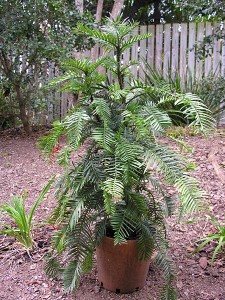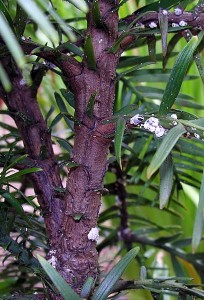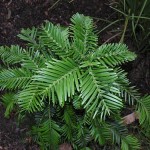I have Australian native Wollemi Pine
 Wollemi Pine, scientific name Wollemia nobilis belongs to family Araucariaceaeis is Australian native prehistoric Jurassic tree plant 200 million plus years old. This tree outlived dinosaurs and now we know it is one of the rarest and oldest plans found on the Earth. Wollemi Pine was able to adapt to Australian diverse climate weather temperatures ranging from -12°C to 45 °Celsius which is +10.4°F to 113 °Fahrenheit.
Wollemi Pine, scientific name Wollemia nobilis belongs to family Araucariaceaeis is Australian native prehistoric Jurassic tree plant 200 million plus years old. This tree outlived dinosaurs and now we know it is one of the rarest and oldest plans found on the Earth. Wollemi Pine was able to adapt to Australian diverse climate weather temperatures ranging from -12°C to 45 °Celsius which is +10.4°F to 113 °Fahrenheit.
Wollemi Pine characteristics
Characteristic for Wollemi Pine is its interesting bubbly looking bark, multi stemming growth and mainly the unusual fern plant like shape green foliage. Till discovery of living Wollemi Pines’ humans  could see design of this foliage only on prehistoric fossils.
could see design of this foliage only on prehistoric fossils.
Caring for Wollemi Pine
Wollemia nobilis like many other Aussie native plants loves sun, it’s hardy, needs not too much water and is low maintenance when free planted as specimen tree outside in the backyard. During autumn season you might start to see white polar caps developing on wollemi pine branches and main stem. These white spots are naturally occurring to protect growing tips underneath from cold winter weather.
It is a very waterwise plant requiring well drained soil, in poorly drained soils mounding should be applied such as natural elevation or to create a small hill and plant on top.  Wollemi Pine will reach 20 meters in height and needs 3 meters free radius of space around. Water well when planted, then like with many native plants, water again once the soil moisture starts to dry. If pruning is necessary it should be done in late autumn. Use slow release low phosphorous fertilizer.
Wollemi Pine will reach 20 meters in height and needs 3 meters free radius of space around. Water well when planted, then like with many native plants, water again once the soil moisture starts to dry. If pruning is necessary it should be done in late autumn. Use slow release low phosphorous fertilizer.
Keeping Wollemi Pine in a pot
Wollemi plant in a pot prefers a sheltered position in shade outdoors. If kept indoors place the pot in well lit area. Potting soil should be draining. Moist the soil only when it starts to dry, never keep moisture levels high, don’t leave water stand around bottom. Apply slow release for Australian native plants low phosphorous fertilizer.
- SPRING beginning of spring is the best time to re plant or re pot your Wollemi. Warmer weather of early spring and use of fertilizer encourage new roots, foliage growth and and in a growth spurt on the tree main stem. Late spring brings main stem to flush with new beautiful light-green growth contrasting with the old darker green foliage.
- SUMMER at early summer new foliage starts to harden turning into deep green color. Bark can ooze a fragrant white sticky sap caused by forming of new buds. Branches unfurl from the new growth on the main stem. If the tree is over 7 years old you may see male and female cones developing on on branches’ tips. Moisture levels should be checked regulary now during hot months. Ensure the plant is not exposed to the direct full sun if grown in a pot. At the end of summer apply slow release low phosphorous fertilizer.
- AUTUNM cooler weather is the ideal time to replant Wollemi Pines outside into the ground. Foliage begins to harden and still some minimal growth or flushing may occur. At this time the white naturally occurring polar caps can develop mainly on the main stem.
- WINTER more of the polar cups will be developing, they cover to protect new growing tips from cool winter weather.
By buying and owning a Wollemi Pine you are protecting and growing its population.
Respond to the I have Australian native Wollemi Pine article:
6 Comments
Sorry, the comment form is closed at this time.
Slight browning of leaves/needles. In pot s.w. Scotland. Taken indoors on coldest of nights in winter 09/10. Otherwise outside.
By wollemi pine
I’ve never seen one of these Wollemi Pines before but I know they origins come from Australia, New South Wales a bit inland where the pine trees were discovered as the only one unique location in the world. Is it actually in the pine family? So cool! I live in Seattle, WA, and I honestly can’t recall ever running across one of these in any nursery I’ve visited before.
By Garden Greenhouse Guy
We live in Minnesota so I’ve had a close call leaving mine on the patio in a surprise hard freeze.
It was nice to know that they are hardy to 10 degrees f.
I also learned, the hard way, that they don’t like the direct summer sun.
Needles turned burgundy with sun burn.
We got ours from a rather eccentric older woman who apparently purchased it through National Geographic.
That’s why we named the pine, Helen.
By peter
I have three of the first Wollemia nobilis that were propagated in the USA. The small one is 10′ tall and the biggest one is 14′ tall. These are some of the largest to be found in the US.
By Charlie
Where do I get the tree?
By Green
I purchased this Wollemi pine tree from our plant nursery shop, this is Brisbane, Australia. Pricey kind but rather unique too to have at home to look at it every day. Some places sell them and some not. My advice is to chat with a competent person in a gardening shop where they sell Wollemi pines, who understands Wollemi’s well, about how to care for them correctly. It is wise to listen for the details closely. As soon as you see some changes on this tree, literary run there back for a good advice. I do not exaggerate for no reason! These trees can be quite tricky till you get to know them properly. I have seen Wollemi pines on the market around Europe already 3 years ago (it is September 2013 now). Here is the first of all links to start with for ordering a Wollie online – prices are on their page.
By Rado